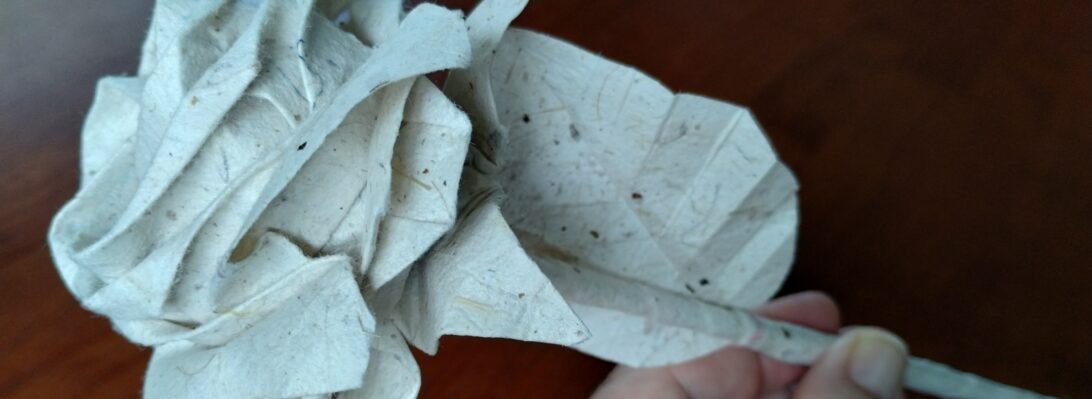If it walks like a duck, quacks like a duck and looks like a duck, it probably is a duck:
This is an intense little model that eats paper like few others. The body is heavy and shaping I found difficult because of the many layers. Continue reading

If it walks like a duck, quacks like a duck and looks like a duck, it probably is a duck:
This is an intense little model that eats paper like few others. The body is heavy and shaping I found difficult because of the many layers. Continue reading
Pressed for time, I folded a model I had meant to fold a month ago:
This is Oriol Esteve’s “Nosy Cat” – a lovely little cat that in my first fold looks more like a kitten. Continue reading
Le Papillon de Nuit translates, roughly as “The Night Butterfly” – a charming fold with a lovely detailed abdomen:
Unlike the other La Fosse butterflies, this one works and then re-works layers on the wings, making the finished model smaller but unique in shape. Continue reading
Catching up, finally, and continuing exploration of the form, this is a luna moth: apparently the main difference between a moth and a butterfly is that moths typically do not have winds that meet above the body – I may have just made that up:
I like the slight “swallowtail” formation here – lots of work pre butterfly formation in getting proportions right makes this seem graceful. Continue reading
Yes, I know, it is a day late, but i have been busy marking, so, yeah:
This is another Michael LaFosse butterfly – more fancy than most with the pleaty zig zags adding decorative touches. Continue reading
Continuing my exploration of the butterfly form, where better to look than a lovely papillon from Michael LaFosse’s “Butterflies” bible:
This lovely little flapper again uses bicolour paper cleverly, has a nice efficiency of final model size for starting paper size and was fun to fold. Continue reading
Scrumbling through my “must fold list” I came across a curious hand-drawn diagram set from Spain and decided to give it a whirl:
After much torturing (I started with a 35cm square) the result is a rather lovely goat. I think this is my favourite farmyard animal so far – lovely proportions, fantastic modelling potential. Continue reading
Dragons are an origami staple (although using staples is cheating!):
I am always on the lookout for a nice design and Hojyo Takashi’s Dragon is no exception. Continue reading
As I continue to explore the butterfly form, I am amazed by the similarities and differences in approaches taken by origami designers:
It seems the references are firmly divided on what the collective noun for butterflies is. Some say swarm, some flight, others wing. What do you think?
I am on the lookout for others – suggestions please.
Cruising teh interwebs for today’s fold, a butterfly design was shared on the Sydney Origami Society’s Fakebook feed:
This is Rikki Donachie’s Butterfly, a lovely simple but effective butterfly design. Continue reading
The internet is an amazing thing, it affords connections between mortals and luminaries in the field:
I noticed Sara Adams (a living legend in the Origami World) was asking for test folders to test diagrams she was drawing and I immediately put my hand up. Continue reading
I am nothing if not determined at times. This model has beaten me many times but, due to a perfect storm it seemed to just happen in my hands:
This is Satoshi Kamiya’s “Tsuru Rose” – an odd but beautiful combination of a Kawasaki rose twist in the body segment of a traditional Tsuru. Continue reading
When I was in Japan, I bought 2 origami books and have not really folded much from them to date:
The books are totally in Japanese, no English at all so I have NO idea who the designer of this model is.
Made from 4 squares of paper (back legs, front legs, head, tusks) and this is a little beauty. Continue reading
Browsing a BOS convention booklet, I came across a rather nice butterfly designed by Ronald Koh:
This is the Tumasek butterfly, I folded it in duo yellow/green paper making it a little like a cabbage white butterfly. Continue reading
A craze among the young kids at the moment is the “fidgit spinner“, that little toy that … spins, and … well, that is just about it:
According to some fairly shady “research”, these toys improve concentration, and that may be correct for a limited number of kids with specific learning issues, but, yeah.
Enterprising businesses sell these, advertise “tricks” you can do with them, and offer ways to pimp out your rig in ways that, well, make it more fully sick. Continue reading